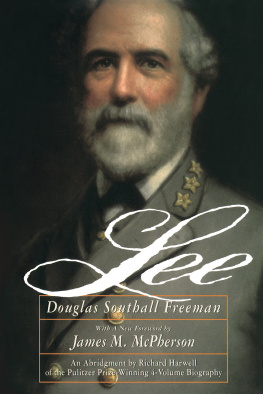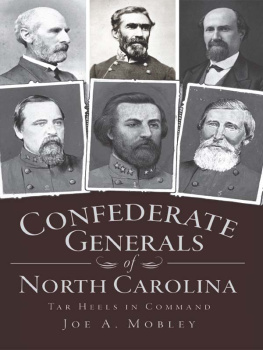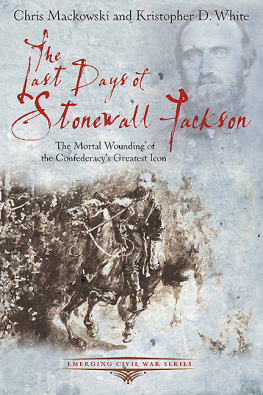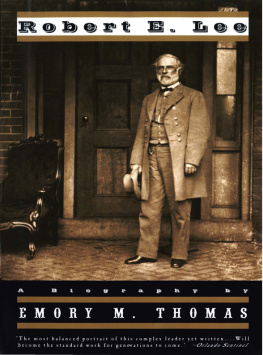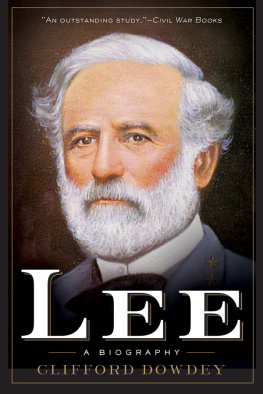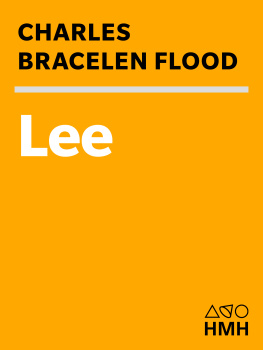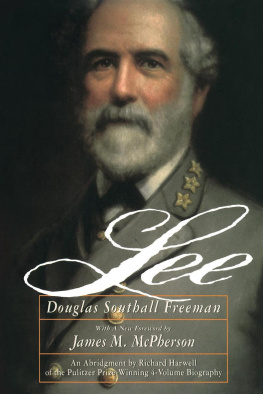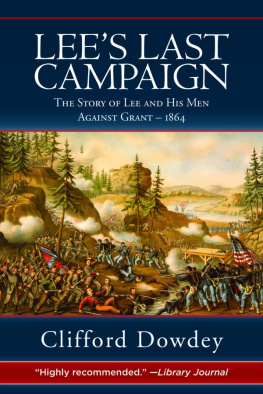
BOOKS BY
DOUGLAS SOUTH ALL FREEMAN
R. E. LEE (4 volumes, illustrated)
WINNER OF THE PULITZER PRIZE FOR BIOGRAPHY
LEE (Illustrated)
AN ABRIDGMENT IN ONE VOLUME BY R ICHARD H ARWELL OF THE CLASSIC
FOUR-VOLUME R. E. Lee
LEE OF VIRGINIA (Illustrated)
THE LIFE OF THE GENERAL TOLD FOR YOUNG ADULTS
LEES LIEUTENANTS (3 volumes, illustrated)
GEORGE WASHINGTON (7 volumes, illustrated)
WINNER OF THE PULITZER PRIZE FOR BIOGRAPHY

ROBERT E. LEE : April, 1865
Thank you for purchasing this Touchstone Book eBook.
Sign up for our newsletter and receive special offers, access to bonus content, and info on the latest new releases and other great eBooks from Touchstone Book and Simon & Schuster.

or visit us online to sign up at
eBookNews.SimonandSchuster.com
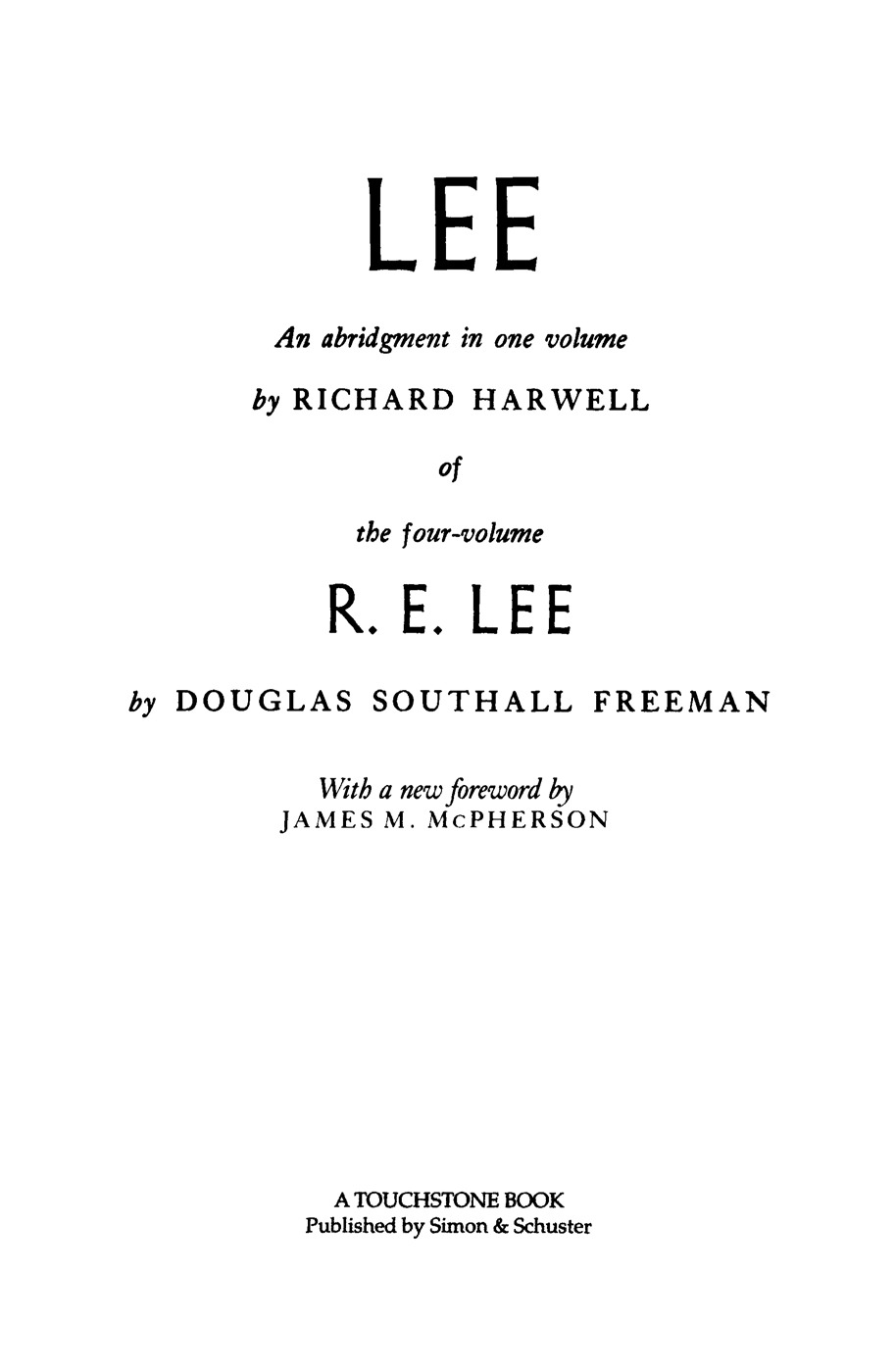
CONTENTS
Library of Congress (Brady Collection)
Wayne Andrews
National Archives
Cook Collection, Valentine Museum, Richmond, Virginia
National Archives (U. S. War Department)
National Archives (Brady Collection)
Library of Congress (Meserve Collection)
National Archives (U. S. Signal Corps, Brady Collection)
Cook Collection, Valentine Museum
Cook Collection, Valentine Museum
Library of Congress (Brady Collection)
National Archives (U. S. Signal Corps, Brady Collection)
National Archives (U. S. Signal Corps, Brady Collection)
Library of Congress
Cook Collection, Valentine Museum
Library of Congress
National Archives (U. S. Signal Corps, Brady Collection)
National Archives (U. S. Signal Corps, Brady Collection)
Library of Congress
Cook Collection, Valentine Museum
Cook Collection, Valentine Museum
Cook Collection, Valentine Museum
Cook Collection, Valentine Museum
National Archives (U. S. War Department)
National Archives (U. S. Signal Corps, Brady Collection)
Library of Congress
Library of Congress
National Archives (U. S. Signal Corps, Brady Collection)
National Archives (U. S. Signal Corps, Brady Collection)
Wayne Andrews
Library of Congress (Brady Collection)
The Confederate Museum
In 1986 a Virginia historian praised Douglas Southall Freemans multivolume biographies of Robert E. Lee and George Washington as definitive portrayals of national heroes. Most Americans would read these words without a second thought. So pervasive has become the image of Lee as a national hero that we tend to forget that he fought four years to break up the United States, and came perilously close to accomplishing that goal.
The transformation of Lee from the foremost Rebel to a great American has been the product of many pens. But no author has done more than Douglas Southall Freeman to shape our image of Lee as a reluctant secessionist who was brilliant in victory, honorable in defeat, and admirable for his commitment to binding up the wounds of war in the re-United States. The sheer virtuosity of Freemans prose, backed by twenty years of research, made Lee first in war, first in peace, and second only to Washington and Lincoln in the hearts of his countrymen.
Like all legends, the Lee legend that Freeman helped to create contains a great deal of truth. If Lee was not the greatest military strategist of the Civil War (a distinction now generally accorded to Grant), he was clearly its greatest tactician and most charismatic commander. If he was not as reluctant to support slavery and secession as myth would have it, until his own state seceded he did hope that disunion could be avoided and he used his powerful influence for reunion after Appomattox. If he was not the demigod enshrined in marble or bronze in countless Southern communities, he was nevertheless a gentleman in the classic sense of that word and a worthy representative of the Virginia gentry that did so much to shape the early history of the United States.
Freeman portrayed a Lee almost without blemishes or warts. In the index of the original four-volume biography is the entry Personal Characteristics, which include: abstemiousness, alertness, amiability, boldness, calmness, charm of manner, cheerfulness, courage, courtesy, dignity, diligence, fairness, faith in God, friendliness, generosity, goodness, good judgment, good looks, grace, heroic character, humility, integrity, intelligence, justice, kindness, mercy, modesty, patience, poise, politeness, resourcefulness, sincerity, tact, thoughtfulness, wisdom. All of these characteristics stand out with even more clarity in this one-volume abridgment, which of necessity strips away much of the verbiage of the original but retains the essence.
Recent studies of Leeparticularly Thomas L. Connellys The Marble Man (1977) and Alan T. Nolans Lee Considered (1991)have put in the warts and blemishes, perhaps too prominently. But the power of Douglas Southall Freemans pen will probably keep the heroic image of Lee preeminent in the eyes of most beholders. Lee, wrote Freeman in the concluding pages of the biography, was one of the small company of great men in whom there is no inconsistency to be explained, no enigma to be solved. What he seemed, he wasa wholly human gentleman, the essential elements of whose positive character were two and only two, simplicity and spirituality. In a subsequent public lecture, Freeman described Lee as one of the few, the very few of her sons, whom America offers at the altar of the ages as worthy by reason of his character to be exempted from the else-universal sentence of death. After reading this biography, we are almost prepared to believe it.
Freeman came honestly to his hero-worship of Lee. The son of a Confederate veteran who had survived to be one of the hardy few to surrender at Appomattox, Freeman learned the valorous legend of the Army of Northern Virginia at his fathers knee. Moving with his family from Lynchburg to Richmond in 1891 at the age of five, Douglas attended a private school whose headmaster, also a Confederate veteran, gave his boys a weekly talk on moral conduct illustrated by anecdotes from the life of General Lee. At the age of seventeen, Douglas attended with his father a reunion of twenty-five hundred Confederate veterans at the famous battlefield of the Crater near Petersburg. Young Freeman there resolved, as he later recalled, to preserve from immolating time some of the heroic figures of the Confederacy.... The memory of the tattered old ranks, the worn old heroes who charged up Crater Hill will ever be fresh in my memory.
That memory remained fresh through Freemans years of graduate study at the Johns Hopkins University, from which he received a Ph. D. in history at the remarkable age of twenty-two. Unfortunately, the only copy of his dissertation, a study of Virginias secession convention, went up in smoke when the downtown campus of Hopkins burned in 1908. The new Ph.D. chose a career in journalism rather than teaching. He went to work for the Richmond Times-Dispatch in 1909; in 1915, at the age of twenty-nine, he became editor of the News Leader , a post he held for thirty-four years. But Freeman never forgot those tattered heroes and their leader. In 1911 he came into possession of Lees confidential wartime dispatches to Jefferson Davis, which had been missing and presumed lost since the Confederate evacuation of Richmond nearly half a century earlier. Freeman edited and published Lees Confidential Dispatches in 1915, doing such a skillful job and writing such a brilliant introduction that he leaped into the forefront of historians of the Confederacy. Lee the soldier was great, wrote Freeman in this introduction, but Lee the man and Christian was greater by far.... Noble he was; nobler he became. The sufferings he endured were worth all they cost him in the example they gave the South of fortitude in disaster and courage in defeat.
Next page
